- Selection Criteria For My Choices
- Best Nikon Macro Lens: Nikon AF-S VR Micro-Nikkor 105mm f/2.8G IF-ED Bundle
- Best Nikon Wide-Angle Lens: Nikon AF-S Nikkor 14-24mm f/2.8G ED
- Best Nikon Telephoto Zoom Lens: Nikon AF-S Nikkor 70-200mm f/2.8E FL ED VR
- Conclusion
- Best Canon Macro Lens: Canon EF 100mm f/2.8L Macro IS USM
- Best Canon Wide-Angle Lens: Canon EF 16-35mm f/2.8L III USM
- Best Canon Telephoto Zoom Lens: Canon EF 70-200mm f/2.8L IS III USM
- Best Sony Macro Lens: Sony FE 90mm f/2.8 Macro G OSS Bundle
- Best Sony Wide-Angle Lens: Sony FE 16-35mm f/2.8 GM
- Best Sony Telephoto Zoom Lens: Sony FE 70-200mm f/2.8 GM OSS Bundle
- Best Olympus Macro Lens: M.Zuiko Digital ED 60mm f/2.8 Macro
- Best Olympus Wide-Angle Lens: M.Zuiko Digital ED 7-14mm f/2.8 PRO
- Best Olympus Telephoto Zoom Lens: M.Zuiko Digital ED 40-150mm f/2.8 PRO
- Best Fuji Macro Lens: Fujinon XF 80mm f/2.8 R LM OIS WR Macro
- Best Fuji Wide-Angle Lens: Fujinon XF 10-24mm f/4 R OIS WR
- Best Fuji Telephoto Zoom Lens: Fujinon XF 50-140mm f/2.8 R LM OIS WR
- Recap Of The Best Camera Lenses
The best camera lenses aren’t always fixed focal length lenses.
Fixed focal length lenses provide better shallow depth of field than zoom lenses.
But zoom lenses achieve outstanding results compared to the cheaper priced prime lenses.
Image sensors these days provide amazing quality even in low light.
Depth of field has improved thanks to image stabilization which increases sharpness.
Even professional photographers use versatile zoom lenses in their work. Some even consider them their best camera lenses in the camera bag.
Mirrorless cameras also offer a wide range of lenses that include zoom capabilities.
Selection Criteria For My Choices
When selecting the best camera lenses, various factors and criteria are important. These essential factors impact a lens’s versatility, performance and value for money.
I conducted extensive research on the best camera lenses for Nikon, Canon, Sony, Olympus and Fuji. And I have identified the critical factors that led me to the best lenses for each brand.
Choosing the right camera lens is a critical decision for any photographer. Whether you’re a professional or an amateur.
The lens you select has a significant impact on the quality of the images you capture. Your photographic experience becomes a quality one with the best camera lenses.
The lens is often prioritized over the camera body in photography. It handles gathering light and creating the image that reaches the camera’s sensor.
Knowing how to choose the best camera lenses can enhance your photography. And it helps guide your decision-making when looking for the best camera lenses.
The Best Camera Lenses Focal Lengths
Different lenses offer varying focal lengths. They can influence your angle of view, composition and photos you can capture.
Prime lenses have fixed focal lengths unlike zoom lenses which have variable focal lengths.
Wide-angle lenses, for example, allow you to capture more of the scene in a single frame. Making it ideal for landscape photography or architecture.
Wide angle zoom lenses provide a great wide angle shot for a cheaper price than a wide angle prime lens.
When deciding on a wide angle lens make sure you know what you want the wide angle lens to do.
Telephoto lenses allow you to focus closer on subjects outside of short focal ranges.
They are ideal for capturing far-off objects with accurate perspective.
But a super telephoto lens enables you to zoom in on distant subjects with precision. Which is perfect for wildlife or sports photography.
Selecting the appropriate focal lengths is key to achieving your desired photography outcomes.
Importance Of The Lens Aperture Size
The maximum aperture is also a critical factor to weigh when selecting a DSLR lens. The aperture size determines the amount of light it can let in.
Lenses with a larger aperture (represented by a smaller f-number) can gather more light. Allowing you to shoot in low-light conditions without having to increase the ISO. Or use longer shutter speeds.
This also results in a shallow depth of field. Which is useful for creating a pleasant background blur. Also known as bokeh, in portrait photography.
Image Quality, Size And Weight For The Best Camera Lenses
Image quality and sharpness matter when choosing a lens. High-quality lenses provide better edge-to-edge sharpness. And reduce chromatic aberration, distortion and other optical issues.
All optical issues degrade image quality. Investing in a high-quality lens can improve the level of detail and clarity in your photos. This makes it essential for photographers who want to produce professional-grade images.
Additionally, the right lens can improve the handling and usability of your camera. Some lenses are bulky and heavy, which can make them challenging to use for extended periods.
Others are compact and lightweight, making them perfect for travel or street photography. Size, weight and performance all play a crucial role in selecting the best camera lenses for your needs.
One of the primary criteria to consider is the optical quality of a lens. Including sharpness, color rendition, contrast and the ability to reduce optical aberrations.
These include chromatic aberration, distortion and vignetting. A lens with superior optical quality can enhance the final image.
Couple More Criteria For You To Remember
Autofocus performance is another essential criterion. A fast, accurate and silent autofocus system can improve your photography experience.
Technological advancements have yielded lenses with outstanding autofocus capabilities in recent years. Thereby enabling photographers to capture fleeting moments with ease.
The best camera lenses with reliable autofocus performance are valuable for action, sports and wildlife photography.
Build quality and weather sealing are also important factors to consider. A well-constructed lens with durable materials and weather sealing can withstand harsh conditions. Allowing it to last for many years.
I urge investing in the best camera lenses with a solid build and weather resistance. Comes in handy when shooting outdoors or in challenging environments.
Specialized Lenses For Your Camera
Specialized lenses can help you achieve unique photographic effects. Most of which would be difficult or impossible to recreate in post-processing.
For example, a macro lens allows you to capture extreme close-ups of small subjects. Thereby revealing intricate details that would be otherwise missed with standard lenses.
Specialized wide angle lenses are also called ultra wide angle lenses. Sometimes zoom wide angle lenses are also called ultra wide angle lenses.
Fisheye lenses offer a unique, ultra wide angle lens perspective. Which adds an artistic touch to your images.
Distortion is common among fisheye lenses. A fisheye lens creates a warped look to the photo.
Advanced photographers use a fisheye lens to capture a panoramic angle of view. Fisheye lenses provide a surreal effect allowing for better creativity.
Whether you use a fisheye lens will depend on your photographic goals. But a fisheye lens can be a great addition to your photography equipment.
Conclusion For The Best Camera Lenses
In conclusion, it’s important to take the time and research your camera equipment to ensure quality and durability.
Choosing the best camera lenses for your camera is of utmost importance. It allows you to achieve the best possible results in your photography.
Looking for the best camera lenses? Consider different lenses for factors like focal lengths, maximum aperture and image quality.
Investing time and effort into finding the right lens improves your photography skills.
I have done the legwork for you so you can make an informed decision before you buy.
Look over the following reviews I wrote for you below to learn more about popular brand name lenses.
Best Nikon Macro Lens: Nikon AF-S VR Micro-Nikkor 105mm f/2.8G IF-ED Bundle
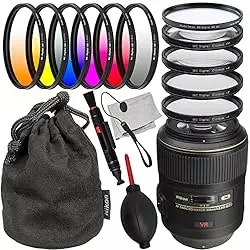
The Nikon AF-S VR Micro-Nikkor 105mm f/2.8G IF-ED is an exceptional macro lens. It’s praised by experts and photographers alike as a quality Nikon lens.
It has a focal length of 105mm and a maximum aperture of f/2.8.
This lens captures striking close-up images with remarkable detail and clarity.
The lens’s built-in Vibration Reduction (VR) system helps to reduce camera shake. Thereby ensuring sharp and stable images even in low-light conditions.
The lens optics provide remarkable sharpness, color accuracy and contrast. All the while minimizing chromatic aberration and distortion.
Its nine-blade rounded diaphragm contributes to a pleasing bokeh. Which is perfect for isolating subjects in macro photography.
The Silent Wave Motor (SWM) ensures fast, accurate, and quiet autofocus performance. Which is particularly useful when photographing insects or other skittish subjects.
The lens’s build quality is also impressive. Featuring a durable construction with dust and moisture resistance. Making it suitable for use in various environments.
To Sum It Up
In short, the Nikon AF-S VR Micro-Nikkor 105mm f/2.8G IF-ED is an outstanding lens.
The following extras come with this
It combines superb optical quality, excellent autofocus performance and effective image stabilization.
It’s an ideal choice for Nikon photographers looking to explore macro photography.
Pros
Cons
Best Nikon Wide-Angle Lens: Nikon AF-S Nikkor 14-24mm f/2.8G ED
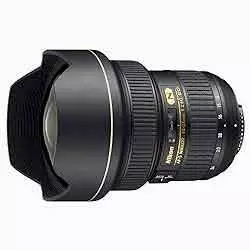
The Nikon AF-S Nikkor 14-24mm f/2.8G ED is an excellent wide-angle lens for Nikon cameras.
This versatile zoom wide angle lens offers a focal length range of 14-24mm. Along with a constant maximum aperture of f/2.8. Which makes it ideal for landscape photography, architecture and astrophotography.
This lens offers excellent sharpness, color accuracy and contrast throughout its focal range. It reduces chromatic aberration, distortion and vignetting.
The lens also features Nikon’s Nano Crystal Coat. It reduces ghosting and flare, providing clear images in difficult lighting conditions.
Autofocus performance is fast and accurate, thanks to its Silent Wave Motor (SWM). SWM also ensures quiet operation.
The build quality of the 14-24mm f/2.8G ED is top-notch. Its durable build and weather sealing enable usage in diverse weather conditions.
Summary
In short, the Nikon AF-S Nikkor 14-24mm f/2.8G ED is a versatile and high-performing wide-angle zoom lens.
It offers excellent optical quality, reliable autofocus performance and a durable, weather-sealed construction.
This is one of the best Nikon lenses in their wide angle lens arsenal.
These qualities make it a great investment for Nikon photographers.
Pros
Cons
Best Nikon Telephoto Zoom Lens: Nikon AF-S Nikkor 70-200mm f/2.8E FL ED VR
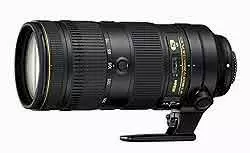
The Nikon AF-S Nikkor 70-200mm f/2.8E FL ED VR is a top-of-the-line telephoto lens. The lens provides exceptional performance and versatility for Nikon photographers.
It uses a focal length range of 70-200mm and a constant maximum aperture of f/2.8. Well-suited for a variety of applications, including sports, wildlife, portrait and event photography.
The lens excels in sharpness, color reproduction and contrast throughout its zoom range. It features an array of advanced optical elements.
Including one fluorite and one high refractive index element. As well as six extra-low dispersion (ED) elements.
These elements work together to cut chromatic aberration, distortion and vignetting. The result is stunning image quality.
The Nikon Vibration Reduction (VR) system provides up to 4.5 stops of image stabilization. Which allows you to capture sharp images even in low light or when shooting handheld.
The Silent Wave Motor (SWM) delivers fast, accurate and quiet autofocus performance. Making it ideal for capturing fast-moving subjects or shooting in sensitive situations.
One of the standout features of the 70-200mm f/2.8E FL ED VR is its build quality. Nikon used a durable magnesium alloy to construct the lens.
And features comprehensive weather sealing, protecting it from dust, moisture and the elements. The sturdy build of the lens handles tough working conditions and professional use.
The telephoto lens has a focus limiter switch, function buttons and tripod collar.
These features make the lens versatile and easy to use. Catering to the diverse needs of amateur and professional photographers everywhere.
Conclusion
In conclusion, the Nikon AF-S Nikkor 70-200mm f/2.8E FL ED VR is one of the top telephoto lenses. It combines exceptional optical quality, reliable autofocus performance and effective image stabilization.
The lens provides a rugged, weather-sealed construction. Nikon photographers seeking a versatile, high-performing telephoto zoom lens will like this lens.
Pros
Cons
Best Canon Macro Lens: Canon EF 100mm f/2.8L Macro IS USM
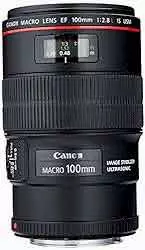
The Canon EF 100mm f/2.8L Macro IS USM is a top choice for macro photography among Canon users.
Comes with a 100mm focal length and a maximum aperture of f/2.8. This Canon lens can capture stunning close-up images with incredible detail and clarity.
One of the standout features of this lens is its Hybrid Image Stabilization (IS) system. Which compensates for both angular and shift camera shake.
This system provides up to four stops of stabilization. Ensuring sharp and stable images even in low-light conditions or when shooting handheld.
The ultra wide angle lens delivers sharpness, color rendition and contrast. Chromatic aberration and distortion get minimized in an effective manner.
This Canon lens uses a nine-blade circular aperture diaphragm. It’s an ideal solution for choosing subjects in macro photography.
The lens features Canon’s Ultrasonic Motor (USM) for fast, accurate and quiet autofocus. This is especially handy when capturing insects or other jumpy subjects.
Additionally, the lens has a focus limiter switch. This allows you to optimize autofocus performance based on the shooting distance.
The build quality of this lens is also impressive. It has solid construction and dust/moisture resistance, suitable for various environments.
Summary
To sum up, the Canon EF 100mm f/2.8L Macro IS USM for its class is one of the best macro prime lenses.
It combines excellent optical quality, effective image stabilization, and reliable autofocus performance.
Ideal for Canon photographers interested in macro photography. This prime lens is one of the better macro lenses on the market.
Pros
Cons
Best Canon Wide-Angle Lens: Canon EF 16-35mm f/2.8L III USM
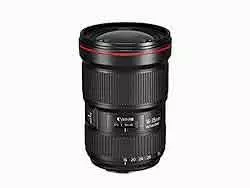
The Canon EF 16-35mm f/2.8L III USM is a high-quality wide-angle zoom lens.
It has a focal length range of 16-35mm and a constant max aperture of f/2.8.
This lens is perfect for landscape photography, architecture, and interior photography.
The ultra wide angle lens delivers great sharpness, color accuracy and contrast. The lens does this across its entire focal range.
It features two large-diameter double-surface GMo aspherical elements and one ground aspherical element. Which work together to cut distortion and spherical aberration.
Additionally, the lens incorporates two UD (Ultra-low Dispersion) elements. Both of which reduce chromatic aberration and ensure high-resolution, high-contrast images.
The lens’s autofocus performance is fast and accurate. Thanks to its Ring-type Ultrasonic Motor (USM) which also ensures quiet operation.
The build quality of the lens is top-notch, with a solid construction and weather sealing. This makes it great for all types of weather conditions.
Conclusion
In conclusion, the Canon EF 16-35mm f/2.8L III USM is a versatile and high-performing wide-angle zoom lens.
I found it to be one of the better wide angle Canon lenses out there.
It offers excellent optical quality, reliable autofocus performance, and a durable construction.
The wide angle lens features weather-sealed protection from dust, moisture and the elements.
It offers features such as a manual focus override. And a zoom lock switch to prevent unintentional focal length changes.
It’s one of the best camera lenses by Canon for non standard wide angle lenses.
Thus making it an excellent investment for Canon photographers.
Pros
Cons
Best Canon Telephoto Zoom Lens: Canon EF 70-200mm f/2.8L IS III USM
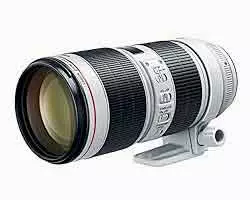
The Canon EF 70-200mm f/2.8L IS III USM is a premium telephoto lens.
Canon users can expect exceptional performance and versatility from it.
Comes equipped with a focal length range of 70-200mm and a constant max aperture of f/2.8.
This Canon lens is ideal for sports, wildlife, portrait and event photography.
This telephoto lens delivers sharp, colorful images with great contrast. It does so throughout the zoom levels.
The lens features one fluorite and five UD (Ultra-low Dispersion) elements. Which reduce chromatic aberration and ensure high-resolution, high-contrast images.
Additionally, Canon’s Air Sphere Coating (ASC) reduce ghosting and flare. Thus ensuring clean and clear images even in challenging lighting conditions.
The lens comes equipped with Canon’s Optical Image Stabilizer (IS) system. Which provides up to 3.5 stops of shake correction.
Allowing you to capture sharp images even in low light or when shooting handheld.
The Ring-type Ultrasonic Motor (USM) delivers fast, accurate and quiet autofocus performance. Making it ideal for capturing fast-moving subjects or shooting in sensitive situations.
One of the standout features of the telephoto lens is its build quality.
It comes constructed with a durable magnesium alloy and features comprehensive weather sealing. Hence allowing protection from dust, moisture and the elements.
The lens can withstand the rigors of professional use and challenging environments.
Other features include:
Conclusion
In conclusion, the Canon EF 70-200mm f/2.8L IS III USM is one of the top telephoto Canon lenses.
It combines exceptional optical quality and reliable autofocus performance.
It also provides effective image stabilization and a rugged, weather-sealed construction.
This lens is an excellent investment for Canon photographers. The telephoto lens handles various zoom applications well.
Pros
Cons
Best Sony Macro Lens: Sony FE 90mm f/2.8 Macro G OSS Bundle
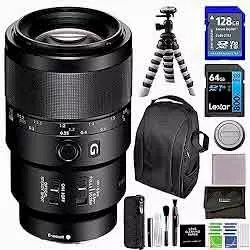
The Sony FE 90mm f/2.8 Macro G OSS is a prime lens selection for macro photography among Sony users.
The lens has a 90mm focal length and a maximum aperture of f/2.8.
This prime lens captures clear and precise close-up images with exceptional definition.
A standout feature is its Optical SteadyShot (OSS) image stabilization system. Which compensates for camera shake.
The OSS system ensures sharp, stable images in low-light or without a tripod.
The lens offers unparalleled sharpness, color rendition and contrast.
With minimal distortion and chromatic aberration, this lens produces sharp and vibrant images.
This lens’s circular diaphragm with nine blades highlights subjects in macro photography.
Direct Drive Super Sonic Wave Motor (DDSSM) ensures fast, precise and quiet autofocus.
This lens also has a focus limiter switch. You can adjust autofocus performance to match the shooting distance with this lens.
The build quality of this lens is also impressive. It features solid construction with dust and moisture resistance.
Summary
In short, the Sony FE 90mm f/2.8 Macro G OSS is an outstanding macro lens.
One of the best camera lenses Sony has developed in a while.
It combines excellent optical quality, effective image stabilization and reliable autofocus performance.
The extra bundle accessories provide you with more tools to get started with macro photography.
I recommend it for Sony photographers getting into macro photography.
Pros
Cons
Best Sony Wide-Angle Lens: Sony FE 16-35mm f/2.8 GM
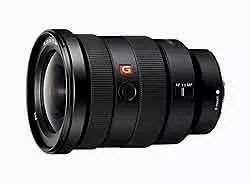
The Sony FE 16-35mm f/2.8 GM is a high-quality wide-angle zoom lens.
This lens has a focal length range of 16-35mm and a constant max aperture of f/2.8.
The perfect go-to lens for photographers who love landscapes, architecture, and interiors.
Sharpness, color accuracy and contrast are excellent for the focal range of this lens.
Designed with two Extreme Aspherical (XA) and three Extra-low Dispersion (ED) glass elements.
Autofocus performance is fast and accurate. This is because of its Direct Drive Super Sonic Wave Motor (DDSSM).
The new technology also ensures quiet operation. The build quality of the 16-35mm GM lens is high quality.
Conclusion
In conclusion, the Sony FE 16-35mm f/2.8 GM is a versatile and high-performing wide-angle zoom lens. Optical quality is outstanding compared to its peers.
This ultra wide lens features a robust, weather-sealed construction. Which provides peace of mind in all weather conditions.
Additionally, the Sony FE 16-35mm f/2.8 GM offers the following convenient features:
The Sony FE 16-35mm GM is one of their better ultra wide lenses. I recommend this high-performing wide-angle zoom lens an excellent choice for Sony photographers.
Pros
Cons
Best Sony Telephoto Zoom Lens: Sony FE 70-200mm f/2.8 GM OSS Bundle
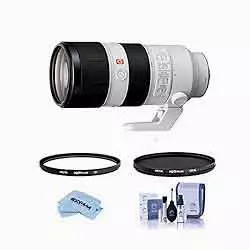
The Sony FE 70-200mm f/2.8 GM OSS is a premium telephoto zoom lens.
Complete with a focal length range of 70-200mm and aperture of f/2.8.
This lens is ideal for sports and wildlife photographers, portrait, and event photography.
The 70-200mm GM OSS lens produces sharp, vivid, and contrasty images at all focal lengths. The lens features one XA element, two aspherical elements, and four ED glass elements.
Additionally, Sony’s Nano AR Coating reduces ghosting and flare. Guaranteeing clean and clear images even in challenging lighting conditions.
Equipped with Sony’s Optical SteadyShot (OSS) image stabilization system for shake free images.
The Direct Drive Super Sonic Wave Motor (DDSSM) gives fast and accurate autofocus. The speedy and quiet motor is perfect for capturing fast-moving subjects.
The 70-200mm GM OSS is its build quality with a durable magnesium alloy.
And features comprehensive weather sealing, protecting it from dust, moisture, and the elements.
Additionally the Sony FE 70-200mm GM OSS also offers convenient features like:
Conclusion
In conclusion, the Sony FE 70-200mm GM OSS is one of the best telephoto lenses.
It combines exceptional optical quality, reliable autofocus performance and effective image stabilization.
The rugged, weather-sealed construction makes this an excellent investment for Sony photographers.
Bundled with the following accessories:
Pros
Cons
Best Olympus Macro Lens: M.Zuiko Digital ED 60mm f/2.8 Macro
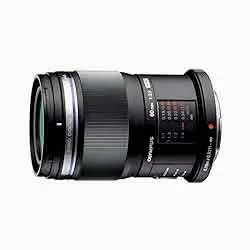
The M.Zuiko Digital ED 60mm Macro is an exceptional macro lens for Olympus users. The lens belongs to the Micro Four Thirds System of older lens.
It offers excellent image quality and performance in a compact package.
Constructed with a 60mm focal length and a maximum aperture of f/2.8.
This lens delivers exceptional sharpness, color accuracy and contrast at every focal length.
The lens features a circular aperture diaphragm. Which is perfect for isolating subjects in macro photography.
Incorporates a focus limiter switch which optimizes autofocus performance based on shooting distance.
The lens features a Movie & Still Compatible (MSC) mechanism. Which ensures a fast, accurate and quiet autofocus system.
These features make the macro lens suitable for both stills and video capture.
The build quality of the M.Zuiko Digital ED 60mm Macro is also impressive.
Featuring a compact and lightweight design with dust and splash-proof construction.
Summary
To sum up, the M.Zuiko Digital ED 60mm f/2.8 Macro is an outstanding macro lens for Olympus users.
It provides excellent optical quality and effective autofocus performance.
A great example of durable construction in a compact package.
Pros
Cons
Best Olympus Wide-Angle Lens: M.Zuiko Digital ED 7-14mm f/2.8 PRO
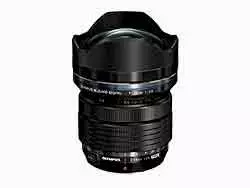
The M.Zuiko Digital ED 7-14mm PRO is a high-quality wide-angle zoom lens. Created for the Micro Four Thirds System, it is one of the older wide angle lenses.
It offers a focal length range of 7-14mm and a constant max aperture of f/2.8.
The 7-14mm PRO lens excels in sharpness, color and contrast. And it does this throughout the entire focal range.
The M.Zuiko Digital ED 7-14mm PRO features the following elements:
In total there are 14 elements in 11 groups providing quality optics.
The lens’s autofocus performance is fast and accurate, thanks to its MSC mechanism. The autofocus mechanism is also quiet which makes it ideal for shots of insects.
Conclusion
In conclusion, the M.Zuiko Digital ED 7-14mm f/2.8 PRO is a versatile and high-performing wide-angle zoom lens.
This wide angle lens offers excellent optical quality and reliable autofocus performance.
Along with a durable construction, making it an excellent investment for Olympus photographers.
Additionally, the wide angle lens offers a manual focus clutch mechanism. Which allows you to switch between auto and manual focus modes.
You can assign various camera functions using the lens’ customizable function button.
Definitely falls into the specialty lenses category.
Even though this is an older lens model, I recommend it for Olympus photographers.
It still qualifies as one of the best camera lenses in the ultra wide lens category on the market.
Pros
Cons
Best Olympus Telephoto Zoom Lens: M.Zuiko Digital ED 40-150mm f/2.8 PRO
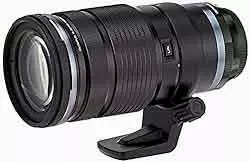
The M.Zuiko Digital ED 40-150mm PRO is a premium telephoto zoom lens.
Its another lens designed for the Micro Four Thirds System.
It comes with a focal length range of 40-150mm and a constant aperture of f/2.8.
This lens is ideal for sports, wildlife, portrait and event photography.
The lens offers exceptional sharpness, color accuracy and contrast at all focal lengths.
The M.Zuiko Digital ED 40-150mm PRO features outstanding optical elements including:
Additionally, Olympus’s ZERO (Zuiko Extra-low Reflection Optical) coating reduces ghosting and flare. Ensuring clean and clear images even in challenging lighting conditions.
It’s equipped with a powerful and silent MSC autofocus mechanism. Which provides fast, accurate and quiet autofocus performance.
Great for capturing fast-moving subjects and/or shooting in sensitive situations.
The 40-150mm PRO boasts exceptional build quality, making it a standout choice.
Including, a rugged all-metal build with dust, splash and freeze-resistant design.
With a diameter of 79mm and a length of 160mm, this lens weighs 880g with the removable tripod collar.
The tripod collar allows you to adjust to any position by rotating it to where you need it. It also is removable lessening the weight by 120g.
This lens balances with the OMD EM1 allowing for a beautiful combination.
Conclusion
In conclusion, the M.Zuiko Digital ED 40-150mm f/2.8 PRO ranks as one of the best camera lenses. It combines exceptional optical quality, reliable autofocus performance and a rugged, weather-sealed construction.
This versatile lens is an excellent investment for Olympus photographers. Perfect for photographers who need versatility in their telephoto lenses.
It has a close focusing distance of 70 cm (27.6 inches) at all ranges of zoom coverage. Which enhances the lens’ flexibility for various photographic scenarios. Allowing you to capture compelling close-up shots even with a zoom telephoto lens
The lens also includes a rotatable, removable tripod collar. Which provides excellent balance and stability when shooting with a tripod or monopod.
This feature is particularly beneficial for photographers working with longer focal lengths. Thereby ensuring steady, blur-free images.
Furthermore, the lens is compatible with the M.Zuiko Digital MC-14 1.4x Teleconverter. Extending the focal length range to 56-210mm (equal to 112-420mm in 35mm format).
The converter does this while maintaining the f/2.8 max aperture. This compatibility makes the lens even more adaptable.
It caters to photographers who need extra reach for specific shooting scenarios.
Pros
Cons
Best Fuji Macro Lens: Fujinon XF 80mm f/2.8 R LM OIS WR Macro
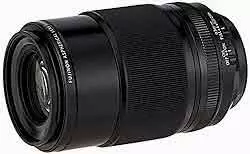
The Fujinon XF 80mm R LM OIS WR Macro is an exceptional macro lens for Fujifilm users.
This lens offers excellent image quality and performance in a robust package.
It comes equipped with an 80mm focal length and a maximum aperture of f/2.8. Which delivers stunning detail and clarity in close-up photography.
The XF 80mm Macro lens delivers impressive sharpness, color rendition and contrast.
The following elements reduce chromatic aberration and distortion:
The lens has a fast and silent Linear Motor (LM) autofocus system. Which provides accurate and smooth focus transitions.
The autofocus system is great for shooting videos of small insects.
Furthermore, the lens features Optical Image Stabilization (OIS). Which offers up to 5 stops of stabilization. Allowing you to capture sharp images even in low light or when shooting handheld.
The build quality of the Fujinon XF 80mm R LM OIS WR Macro is also impressive. The lens is weather-resistant, protecting it from dust, moisture and low temperatures.
Summary
To sum up, the Fujinon XF 80mm f/2.8 R LM OIS WR Macro is an outstanding macro lens for Fujifilm users.
It combines excellent optical quality, effective autofocus performance and a durable construction.
I know Fuji photographers will enjoy adding this great lens to their arsenal of Fuji lenses.
Pros
Cons
Best Fuji Wide-Angle Lens: Fujinon XF 10-24mm f/4 R OIS WR
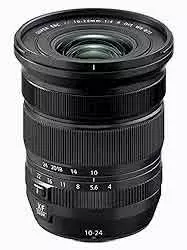
The Fujinon XF 10-24mm f/4 R OIS WR is a high-quality wide-angle zoom lens. It offers Fujifilm users exceptional performance and versatility.
Built with a focal length range of 10-24mm and a constant max aperture of f/4. Which makes this lens is perfect for landscape, architecture and interior photography.
The lens delivers outstanding sharpness, color accuracy, and contrast across its focal range.
This wide angle lens features four aspherical elements and four extra-low dispersion elements.
Which work together to reduce distortion, chromatic aberration and spherical aberration. Thereby ensuring high-resolution, high-contrast images.
The Linear Motor (LM) autofocus system provides fast and accurate autofocus performance. Which also ensures quiet operation.
The build quality of the 10-24mm f/4 lens is top-notch, with a solid construction and weather sealing. Which allows you to use it with confidence in various weather conditions.
Additionally, the Fujinon XF 10-24mm f/4 R OIS WR features Optical Image Stabilization (OIS).
Providing up to 3.5 stops of stabilization. Ensuring sharp, blur-free images when shooting handheld, particularly in low light situations.
This is a valuable photographic feature for ultra wide lenses. As it allows you to capture clear and steady images without the need for a tripod in many situations.
The lens also includes a convenient aperture ring. Which offers precise, tactile control over the aperture settings. So it’s easier to adjust exposure settings on the fly.
Moreover, the lens features a minimal focusing distance of 24cm (9.4 inches). Enabling you to capture compelling close-up shots even with a wide-angle zoom lens.
Conclusion
In conclusion, the Fujinon XF 10-24mm f/4 R OIS WR is a versatile and high-performing wide-angle zoom lens.
It offers excellent optical quality, reliable autofocus performance and durable construction.
Fujifilm photographers will be happy with this ultra wide angle lens.
It has Optical Image Stabilization, weather sealing and close focusing capabilities. Making it a valuable tool for capturing stunning wide-angle images in various conditions.
Pros
Cons
Best Fuji Telephoto Zoom Lens: Fujinon XF 50-140mm f/2.8 R LM OIS WR
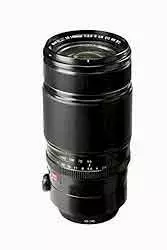
The Fujinon XF 50-140mm R LM OIS WR is a premium telephoto zoom lens.
Built with a focal length range of 50-140mm and a constant maximum aperture of f/2.8. Which makes this lens ideal for sports, wildlife, portrait, and event photography.
The 50-140mm lens excels in sharpness, color reproduction, and contrast. And it does so throughout its zoom range.
The lens features include:
Additionally, Fujifilm’s HT-EBC (High Transmittance Electron Beam Coating) reduces ghosting and flare. Ensuring clean and clear images even in challenging lighting conditions.
Its equipped with a powerful and silent Linear Motor (LM) autofocus system. Which provides fast, accurate and quiet autofocus performance. So it’s ideal for capturing fast-moving subjects or shooting in sensitive situations.
One of the standout features of the 50-140mm lens is its build quality.
It’s constructed with a durable metal body and features comprehensive weather sealing. Making it protected from dust, moisture and the elements.
The lens can withstand rigorous professional use and harsh environments.
Also, the Fujinon XF 50-140mm R LM OIS WR offers Optical Image Stabilization (OIS). The lens provides up to 5 stops of image stabilization.
This feature enables you to capture sharp, blur-free images when shooting handheld. Particularly in low light or when using slower shutter speeds.
Added Benefits Which Make This One Of The Best Lenses
Furthermore, the Fujinon XF 50-140mm R LM OIS WR includes a convenient aperture ring.
This feature allows for quick and accurate adjustments to exposure settings while shooting. Giving you greater creative control over your images.
The lens also features a removable, rotatable tripod collar. Providing excellent balance and stability when shooting with a tripod or monopod
Ideal for photographers working with longer focal lengths. Or capturing subjects that need precise framing and focus ensuring steady, blur-free images.
Moreover, the XF 50-140mm lens is compatible with Fujifilm’s XF 1.4x TC WR and XF 2x TC WR teleconverters.
Which extends the focal length range to 70-196mm (with the 1.4x TC WR). Or 100-280mm (with the 2x TC WR) while maintaining its f/2.8 max aperture.
This teleconverter compatibility makes the lens even more adaptable for Fuji photographers. Providing photographers that extra reach for specific shooting scenarios.
Conclusion
In conclusion, the Fujinon XF 50-140mm f/2.8 R LM OIS WR also ranks as one of the best camera lens.
It combines exceptional optical quality, reliable autofocus performance and a rugged, weather-sealed construction.
Its compatibility with Fujifilm’s teleconverters further extends its capabilities.
Which makes it an indispensable tool for Fuji photographers. The telephoto lens provides high performance and versatility for a wide range of applications.
It uses friendly and practical Optical Image Stabilization, aperture rings and tripod collar. Ensuring an outstanding shooting experience for Fujifilm photographers.
Additionally, the Fujinon XF 50-140mm R LM OIS WR boasts an advanced nine-blade rounded diaphragm. Which contributes to the creation of smooth and pleasing bokeh in out-of-focus areas.
This feature is especially beneficial for both portrait photographers and wildlife photographers. It helps to isolate subjects from their backgrounds, resulting in more appealing images.
The lens also has a small focusing distance of 1 meter (3.3 feet). Allowing you to capture close-up shots even with a zoom telephoto lens.
This capability makes it suitable for various photographic situations. Like capturing intimate portraits or documenting distant subjects.
The Fujinon XF 50-140mm R LM OIS WR prioritizes user comfort in its design.
Featuring an ergonomic design and well-placed controls that make it easy to operate.
Its robust construction ensures that the lens can withstand the rigors of daily use.
The weather sealing provides peace of mind when shooting in challenging environmental conditions.
Pros
Cons
Recap Of The Best Camera Lenses
After extensive research, these are the top 15 DSLR camera lenses for 2023. Taking into consideration, opinions from experts and professionals in the field.
The camera lenses cater to a variety of photography styles and applications. Like capturing intricate details in macro photography to expansive landscapes with wide-angle lenses. And excellent depth of field for distant subjects with telephoto zoom lenses.
Zoom lenses offer versatility in all areas of photography. Not as sharp as what prime lenses offer but darn close. Each will help you create stunning images and elevate your photography skills.
Each camera lens boasts unique features and capabilities that enhance their performance and usability. For example, many of these camera lenses offer image stabilization. Which ensures sharp, blur-free images even when shooting handheld in challenging conditions.
Additionally, several camera lenses have weather-sealed designs. Consequently making them suitable for use in harsh environments. While also protecting them from dust, moisture and the elements.
The camera lenses listed here come equipped with fast, accurate and silent autofocus systems. This enables photographers to capture fleeting moments or track fast-moving subjects with ease.
Moreover, these camera lenses are designed to deliver outstanding optical performance. They use high-quality glass elements and advanced coatings. As a result, minimizing aberrations, improving contrast and ensuring vibrant color reproduction.
These top 15 DSLR lenses for 2023 are the best camera lenses I could find in their class. As a result they’re sure to impress both professionals and enthusiasts.
By choosing any of these lenses, photographers are investing in a high-quality camera lens. Whether you’re a pro or an enthusiast, these camera lenses will surpass your expectations.
